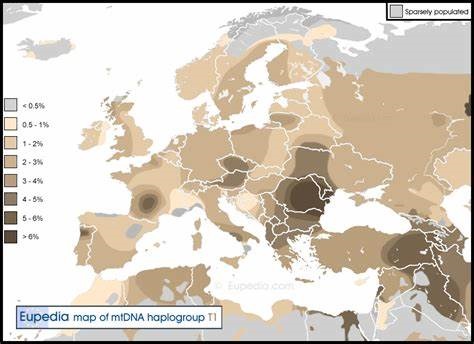The Lie of Afrocentrism
Posted By Morris van de Camp On In North American New Right | Comments Disabled3,618 words
If it is yet not universally known, it is certainly increasingly understood by a large segment of society that academia peddles simplistic ideologies, luxury beliefs, and outright falsehoods. Gender ideology is an obvious house built upon sand, yet no administrator has the courage to wash this harmful ideology away.
The root of the problem is Black Studies departments in universities, alongside Negro Worship [2]. In the 1960s, universities across the United States organized Black Studies [3] departments. These departments then hired ethnonationalist sub-Saharan professors and allowed them to recruit a core of sub-Saharan “students” as muscle for violent and intimidating actions against white university administrators, creating a culture of fear. Since American society has long since been infected with Negro Worship [4], this thuggery has been tolerated for decades.
Black Studies departments have not created anything intellectually valuable. Their output is myth [5] rather than knowledge. Tolerating Black Studies departments and the myths they engineer and propagate have very real negative consequences throughout society. The unhealthy social contagion of Translunacy [6] has aligned with sub-Saharan activists for this very reason. And in 2020, Critical Race Theory served as an ideological vehicle for violence and election fraud.
One of the frauds perpetrated by Black Studies is the notion of Afrocentrism. Afrocentrism is the theory that the Egyptians were originally sub-Saharan Africans who were related to today’s slave-descended American blacks. Afrocentrists argue that sub-Saharan Negroes created Egyptian civilization, but that its heritage was stolen by the Greeks. Sub-Saharans thus lost their technological edge and were later exploited and enslaved by whites. Afrocentrism became especially predominant in the 1990s, and is occasionally espoused by sub-Saharan celebrities presently [7].
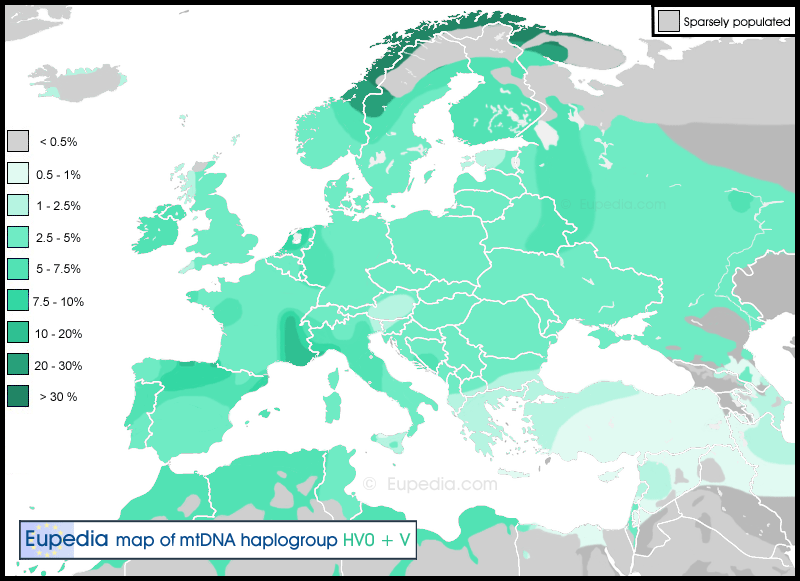 [9]
[9]Top: mtDNA Haplogroup T1 [10]. Bottom: mtDNA Haplogroup V [11]. These DNA markers show that the peoples of Europe and North Africa were interrelated, long ago. The main difference today is the result of to the rift between Islam and Christianity. The peoples of North Africa are indigenous Africans, but they are not sub-Saharan Negroes. It is this slippery use of the word “African” which Afrocentrists propagate to further their belief system.
Race in Africa
The racial situation in Africa today must first be described in order to refute the Afrocentrists’ false claims. Africa [12] is an enormous continent which is home to five human DNA clines [13] (races) among its indigenous population. In North Africa, including Egypt, the people are Caucasian (whites). Western North Africa one can find many people who are indistinguishable from northern Europeans, such as the Rif Berbers [14].
DNA analysis of ancient Egyptian mummies [15] shows that they were related to the Early Farmers [16] who first adopted agriculture in the Fertile Crescent and then spread across the Mediterranean region. The source of Egypt’s agricultural prosperity was the Nile River, whose waters come from Central Africa’s tropical rains. This excess water from the monsoon reaches Egypt by August, just after the crops are harvested. With the Nile’s flood comes new soil deposits, so the farmland is replenished each year. There was therefore no salinization problem [17] in Egypt as there was in Mesopotamia [18].
With a steady supply of grain, the Egyptians created a great civilization that included a complex theological system; an early, albeit clunky, writing system; grand monuments; and the first large-scale political system.
 [19]
[19]The civilization of ancient Egypt was unquestionably great. Many sub-Saharan activists in America started to believe that they were descended from the ancient Egyptians as early as the 1840s.
While Egypt didn’t directly influence Greek philosophy, it is unquestionable that it had influence on Western Civilization in other ways. For a time at least [20], Egyptians were the first to practice monotheism, and Psalm 104 [21] is very likely derived from The Great Hymn of the Aten [22].
The Greeks had colonies in Egypt 600 years before Christ, and they founded Alexandria in 331 BC, which became the Eastern Mediterranean’s greatest city. But the historical record shows that Egypt was often ruled by others, such as the Hyksos [23], so the idea that Western Civilization was entirely the result of Egyptian influence is impossible.
In antiquity, North Africa west of the Nile River Valley and Delta in Egypt was sparsely settled. The two great cities in North Africa, west of Egypt, in ancient times were Carthage and Cyrene [24]. Carthage [25] was settled by the Phoenicians [26], and Cyrene by the Greeks [27].
The whites of these civilizations are separate and distinct from the dark-skinned Negroes from south of the Sahara Desert. The only link between North Africa and the rest of the continent in antiquity was through the narrow corridor of the Nile River. There was some migration, but it was limited. Traversing the length of the Nile is so difficult that it was only achieved in the late 1850s by a group of dedicated British explorers. On Africa’s northeast coast, there was maritime trade, but it was dominated by the Egyptians, Greeks, and Near Eastern peoples.
South of the Sahara, there are four other distinguishable races. Two are very primitive. In Central Africa there are the Pygmies, a hunter-gatherer group of short stature. The Khoisan, or Bushmen, live in Southwest Africa and are also hunter-gatherers.
 [28]
[28]The Khoisan, or Bushmen, are a race of hunter-gatherers who constitute their own racial category.
In Madagascar, off Africa’s southeastern coast, the population is Austronesian [29]. DNA studies have confirmed that they originated in Borneo [30]. Obviously, the Austronesians arrived in Madagascar by sea, although it is uncertain if their settlement was deliberate or accidental. Exactly when the first settlers arrived in Madagascar is likewise unknown. There are some mainland African Bantu people in Madagascar as well. It is possible that they migrated to Madagascar on their own, or perhaps were brought there by Austronesian sailors as a labor force. What is certain is that they arrived long after the Austronesians.
Ethiopia and the Horn of Africa contain Negroes, but they are completely different from the sub-Saharans. There is an ancient connection between the Ethiopians [31] and the Near East via the Nile, and maritime connections from Arabia, however.
Ethiopia is host to several Semitic languages [32], and Ethiopians have different features than sub-Saharans do. There is a controversy among scholars as to whether the Semitic language originated in Ethiopia or the Middle East, although the latter is more probable [33].
 [34]
[34]The locations where Semitic languages were spoken in antiquity shows the limits of the contact between the Caucasians in the Near East and sub-Saharan Africa.
The rest of Africa is populated by the Bantu people. Many of the United States’ sub-Saharans are related to the Bantus. They were able to domesticate the guinea fowl and farm bananas, millet, taro, and yams. They were also able to acquire goats, cattle, and sheep, Probably through the Nile and east African maritime trade connections. They were unable to use domesticated horses because tropical African diseases killed them off. Zebras are related to horses, but since they evolved in Africa they are immune to local diseases — but they cannot be domesticated. The Bantus spread southwards and arrived in what is now South Africa at about the same time that the European Afrikaners did.
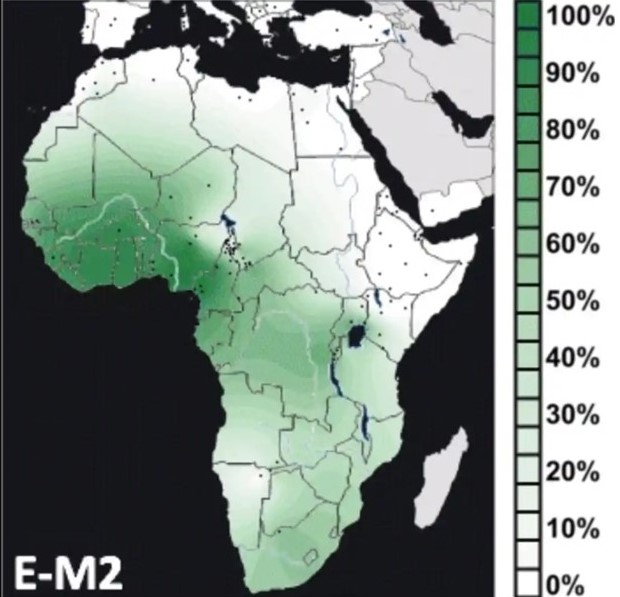 [35]
[35]The E-M2 DNA marker shows the spread of the Bantu people. Bantus are related to those sub-Saharans who were brought to the Americas as slaves. E-M2 markers are not present in North Africa, Ethiopia, or Southwest Africa.
Racial categories in Africa are easy to describe and obvious to any observer. In the 1960s, the organized Jewish community in conjunction with the media attacked Carleton Coon [14], a pre-eminent American physical anthropologist of the time, so viciously for providing scientific evidence to support race realism that other scholars in the same field were terrorized into silence. Anthropologists then started to claim that race doesn’t exist and that racial differences in IQ are due to social problems and so on. This helped to allow sub-Saharans to begin using the slippery word “African” to imply that they were the ones who created Egyptian civilization.
Afrocentrist ideology’s background
What became Afrocentrist ideology first began to develop in the United States among sub-Saharan clergymen as early as the 1840s, during the abolitionist campaign prior to the US Civil War. It was claimed that sub-Saharan slaves were descended from a glorious and ancient African civilization, and thus that their servitude was unjust. This obviously untruthful propaganda hardened Southern attitudes. White Southerners knew better, since they had had intimate experience with sub-Saharans since they had first imported them to Jamestown in 1619. This propaganda in part led to America soaking in blood between 1861 and 1865.
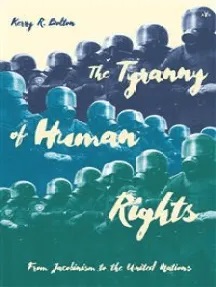 [36]
[36]You can buy Kerry Bolton’s The Tyranny of Human Rights here [37].
The generation of sub-Saharans who grew up after the war sharpened their proto-Afrocentrist ideas. None of them conducted actual scientific research on Egypt, however. They didn’t examine mummies to determine their race or compare the writing systems of Egypt and Nubia. They rather derived their theories from the Bible or ambiguous passages in ancient Greek texts. They also interpreted these texts through the lens of their own experience. For example, Aesop, who wrote the famous fables, had been a slave; therefore, he must have been a sub-Saharan Negro like them.
Some of this proto-Afrocentrist propaganda emerged from Freemasonry. Masonic lore claimed that their rites had originated in Egypt. One influential text was “About the Mysteries of Egypt,” published an issue of the Journal for Freemasons in 1784. Many sub-Saharans joined a sect of Freemasonry called the Prince Hall Masons, and which had been formed specifically for them. This lore is pure fiction, however; in fact, Masonry originated in Europe.
By the time of the First World War, sub-Saharan attempts to claim ancient Egyptian civilization grew more strident. William H. Ferris [38] argued that civilization had begun in Ethiopia and then spread to Egypt. He also argued that ancient Egyptians had been of mixed race, like mulattos in the United States.
George W. Ellis [39] further developed the idea that Egypt had been a sub-Saharan Negro civilization influenced by Ethiopia. He also tied Egypt to ancient Ghana and the West African kingdoms. His purpose at the time was to create propaganda in support of Liberia, but his writings became source material for later Afrocentrists.
None of this is true. The Egyptians were darker than the Greeks and Northern Europeans. While by definition they were indigenous Africans, they were nevertheless Caucasians. Racial scientists in the late nineteenth century classified the Egyptians as part of the Mediterranean Race, along with Greeks, Arabs, North Africans, and southern Europeans.
The 1960s: Afrocentrism takes over
Afrocentrism’s influence grew due to three flaws in American law. The first was the mistake of allowing sub-Saharans to become American citizens following the Civil War. The second was allowing sub-Saharans migrants to naturalize. The final one was the fiction that the British West [40] Indian [41] colonies contained British citizens who could therefore immigrate to the United States as “British” under the immigration quota system that was set up as part of the restrictive immigration laws that the US introduced between 1917 and 1924.
As a result of these mistakes, sub-Saharans from the West Indies began arriving in the US and staying, opting for New York City and other major cities as opposed to the South. These West Indians arrived with a proto-Afrocentrist ideology of their own creation. This most famously includes Rastafarianism, which holds that Ethiopia’s Emperor Haile Selassie was the fulfillment of Biblical prophecy.
West Indian sub-Saharans integrated their ideas with those of American sub-Saharan activists and began publishing metapolitical material. Marcus Garvey [42] went so far as to turn reality on its head. He argued that whites had “stolen” knowledge of the arts and sciences from Africa in ancient times, and that whites had been practicing cannibalism and human sacrifice before this crime — as opposed to the sub-Saharan tribes that Christian missionaries were trying to convert during Garvey’s lifetime.
Afrocentrism likewise advanced in the French West Indies. In the early twentieth century, Haitian society fell apart and the Woodrow Wilson administration sent US Marines to restore order. The US occupied the nation for the next two decades. During this period, Haitian intellectuals started to write about an imagined glorious African past that had been suppressed by white American [43] occupation troops. These ideas then spread to other parts of French-speaking Africa. Frantz Fanon [44], who was from Martinique, wrote a number of Africanist, anti-colonialist, and Third Worldist texts that influenced sub-Saharan activists around the world.
Another Franco-African writer was Cheikh Anita Diop [45] of Senegal. Although what became Afrocentrism has roots in America’s pre-Civil War abolitionist movement, Afrocentrism as we know it today can be traced to his works. The scholar Stephen Howe has described his work as involving many unsubstantiated claims.
To put it simply, Diop cherry-picked the evidence to claim that there had been cultural transmission from sub-Saharan Africa to Egypt, and then from Egypt to Greece, and from Greece to the rest of Europe. He ignored evidence to the contrary, including new discoveries in the field of Egyptology. He also infused his works with Marxist ideology. Despite criticism of Diop’s shoddy scholarship, he was hailed for his efforts and continues to be.
A major Afrocentrist today is Molefi Kete Asante [46]. He was born in a small town in Georgia in 1942 and was given the name Arthur Lee Smith, Jr. He changed it after visiting Ghana. Asante is currently a Professor in the Department of Africology at Temple University. He claims that sub-Saharan Bantus populated ancient Egypt, and that all civilizations that arose elsewhere were derived from knowledge stolen from them. His ideas are not significantly different from what Afrocentrists such as Diop and others have been saying since the 1840s.
Afrocentrists became untouchable in American academia starting in the late 1960s, when the African Studies Association (ASA) was a prominent force. The ASA was originally mostly made up of white scholars, but in 1968 a “black caucus” was formed within the ASA, led by John Henrik Clarke [47] of Hunter College. Most of the black caucus’ members were not even in the ASA. At the ASA’s conference in Montreal in 1969, Clarke led a physical attack on the conference which eventually shut it down. They then won concessions from the ASA that steered it towards promoting Afrocentrism, Pan-Africanism, and de-colonialist ideology.
This event was part of a general trend in Black Studies. From that point onward the field was no longer concerned with studying facts, but instead focused on ideology and black ethnonationalist politics backed by violence and threats of violence. White scholars simply backed down; the tide of Negro Worship and “civil rights” was strong by then.
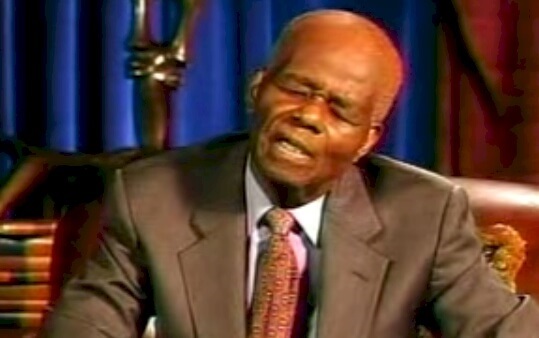 [48]
[48]John Henrik Clarke was a major proponent of Afrocentrism. He propagated a mythical idea of ancient Egypt and the origins of civilization that wasn’t based in fact, but was able to advance his views by threatening violence using his followers. None of this thuggery was ever challenged.
Afrocentrism’s high point in the early 1990s
The political Left was in power in America during the 1990s, but white racial realist activists were still free to make their case in public. They, along with implicit race-realists and ordinary people merely seeking the truth, won a partial victory against Afrocentrism, but not a decisive one.
Afrocentrist ideology developed an enormous following between the 1960s and the 1980s. It grew unseen because of the soft bigotry of low expectations. No one anticipated that the idea that sub-Saharan Africa had been the home of the greatest civilization would take hold, given that sub-Saharans’ pathologies as a people are widely known. The fact that knowledge can be coopted for ideological ends was also difficult for genuine scholars to understand.
In late 1989, some academics finally started to push back against Afrocentrism. It started with a critique of one of the ideology’s non-sub-Saharan proponents: Martin Bernal [49] (who was at least partially Jewish). Bernal published a book called Black Athena, arguing that Greek culture, philosophy, and other achievements had been derived from Egypt and that the Egyptians had colonized Greece.
In short, Bernal’s case involved two main points. The first was a comparison of Greek religious stories and religious rituals. Any superficial similarities were used by Bernal as proof of Greek culture’s Egyptian origins. The other was the claim that the fact that there were some words in both classical Greek and ancient Egyptian that sound similar was further proof of Egyptian influence. His idea that the Egyptians colonized Greece was, in fact, entirely wrong, according to other scholars; colonization in fact went the other way.
Black Athena [50] was reviewed [51] by Mary Lefkowitz [52] — a Jew — in 1991. At the time, Lefkowitz was a Professor of Classics at Wellesley College [53]. In her review she showed that Bernal had misinterpreted the evidence. His theories of influence were either obviously wrong or else based on other secondhand sources, such as Masonic lore. Bernal had likewise misinterpreted the linguistic data: classical Greek words were in fact derived from Indo-European sources.
 [54]
[54]You can buy Greg Johnson’s The Year America Died here. [55]
Lefkowitz went on to discover other basic flaws in Afrocentrist ideology. At a lecture by the Afrocentrist Dr. ben-Jochannan [56], Lefkowitz asked how it was possible that Aristotle had stolen ancient Egyptian texts from the library of Alexandria when the library wasn’t built until after Aristotle’s death. Ben-Jochannan didn’t have an answer. Accusations of racism were nevertheless thrown at Lefkowitz. Her supporters at the lecture felt that the situation was “hopeless” and kept silent; Lefkowitz was on her own. She later turned her criticisms of Afrocentrism into a book: Not Out of Africa (1996).
In 1991, John Leo [57], a conservative columnist working for US News & World Report [58], got wind of the controversy and started to write about it. He called seven Egyptologists and asked them if the ancient Egyptians had been sub-Saharans. All of them answered in the negative; Egyptians then and now are Caucasian, though not European. None of the Egyptologists agreed to be quoted, however, fearing reprisals and accusations of racism.
In 1998, Stephen Howe published Afrocentrism: Mythical Pasts and Imagined Homes. This book is a better response to Afrocentrism than Lefkowitz’s Not Out of Africa, going in much greater depth. Afrocentrism started to wither in the sunlight of truth, but it did not completely die.
Afrocentrism’s roots are envy and resentment, not facts. Sub-Saharans in the African Diaspora live alongside whites who build skyscrapers, maintain safe neighborhoods, send rockets into space, and create new industries. They only have a limited role in all of this. Thus, imagining that sub-Saharans laid the foundations for all of this in Egypt is a salve for a deeply wounded ego.
The lost opportunity
Afrocentrism [59] was defeated the moment that genuine scholars began to look into the facts and write about them. Nevertheless, the defeat was only a partial one. Mary Lefkowitz, for example, is a nice Jewish liberal who accepts colorblind ideology and believes that race doesn’t exist [60]. She genuinely accepts the “devil words” about “white supremacy” rather than admit to the obvious and glaring differences between white and sub-Saharan societies.
Looking at Lefkowitz’s ideas from a racially-aware perspective, it is easy to conclude that she is being disingenuous [61]. Ancient Greeks didn’t steal “knowledge” from ancient Egypt, and ancient Egyptians were not sub-Saharan Negroes. As long as Lefkowitz’s disingenuous colorblind arguments continue to be propagated alongside resistance to Afrocentrism and its related ideologies, the problems resulting from “civil rights” will remain. Racial differences are real. Egyptians, while they are Africans, are white Caucasians [62] who are more closely related to the peoples of Europe, the Middle East, and North Africa than to sub-Saharan Negroes.
Afrocentrists nevertheless succeeded in pushing back in a few debates with their critics. One such debate [63] took place between John Henrik Clarke and Martin Bernal on the Afrocentrist side, and Mary Lefkowitz and Guy MacLean Rogers, author of Black Athena Revisited [64] (1996), on the other. The debate took place in 1996 before an audience which was passionately in favor of Afrocentrism.
Lefkowitz and Rogers didn’t win the debate overwhelmingly, because they had made the mistake of going into a situation where their adversaries had prejudiced its outcome before it had even started. The moderator was clearly on the side of the Afrocentrists. She criticized Lefkowitz and Rogers throughout, claiming at one point that she was merely trying to get a “cogent answer” from them — when it is clear she was rather deliberately failing to understand their arguments. The debate itself was also structured so that each participant presented his or her conclusions at the outset, which meant that the audience wouldn’t hear all the evidence for each conclusion beforehand. Clarke did manage to sum up the envy and resentment which is at the root of Afrocentrism, however, saying [63]:
The single point I wish to get across before we start anything: I am not here to debate with anyone. I have devoted all my adult life to this subject. I only debate with my equals, all others I teach.
Clarke’s statement was greeted with applause from the friendly audience. It shows that he was impervious to evidence. Afrocentrism is no different from any other false ideology that is backed by force and propped up by a warped system.
The 1990s debate around Afrocentrism did at least provide metapolitical material for pro-white institutions such as American Renaissance. But unfortunately, nobody in a position of power moved to halt this obviously false ideology’s growth. Tolerating the lie of Afrocentrism means swallowing the lie of “civil rights” as well. It also means that the colorblind sub-Saharan uplift schemes that have cost America so much sweat and treasure is continuing. And tolerating Afrocentrism means tolerating sub-Saharan violence and the Great Replacement.
Perhaps we can take some hope in that Critical Race Theory, a parallel ideology to Afrocentrism, is finally being resisted by politicians. Nonetheless, Afrocentrism, untruth, and the Great Replacement are continuing unabated.
* * *
Counter-Currents has extended special privileges to those who donate $120 or more per year.
- First, donor comments will appear immediately instead of waiting in a moderation queue. (People who abuse this privilege will lose it.)
- Second, donors will have immediate access to all Counter-Currents posts. Non-donors will find that one post a day, five posts a week will be behind a “Paywall” and will be available to the general public after 30 days.
- Third, Paywall members have the ability to edit their comments.
- Fourth, Paywall members can “commission” a yearly article from Counter-Currents. Just send a question that you’d like to have discussed to [email protected] [65]. (Obviously, the topics must be suitable to Counter-Currents and its broader project, as well as the interests and expertise of our writers.)
To get full access to all content behind the paywall, sign up here:
Paywall Gift Subscriptions
 [66]If you are already behind the paywall and want to share the benefits, Counter-Currents also offers paywall gift subscriptions. We need just five things from you:
[66]If you are already behind the paywall and want to share the benefits, Counter-Currents also offers paywall gift subscriptions. We need just five things from you:
- your payment
- the recipient’s name
- the recipient’s email address
- your name
- your email address
To register, just fill out this form and we will walk you through the payment and registration process. There are a number of different payment options.
Bibliography
Stephen Howe, Afrocentrism: Mythical Pasts and Imagined Homes (New York: Verso, 1998)
Mary Lefkowitz, Not Out of Africa: How Afrocentrism Became an Excuse to Teach Myth as History (New York: Basic Books, 1996)

